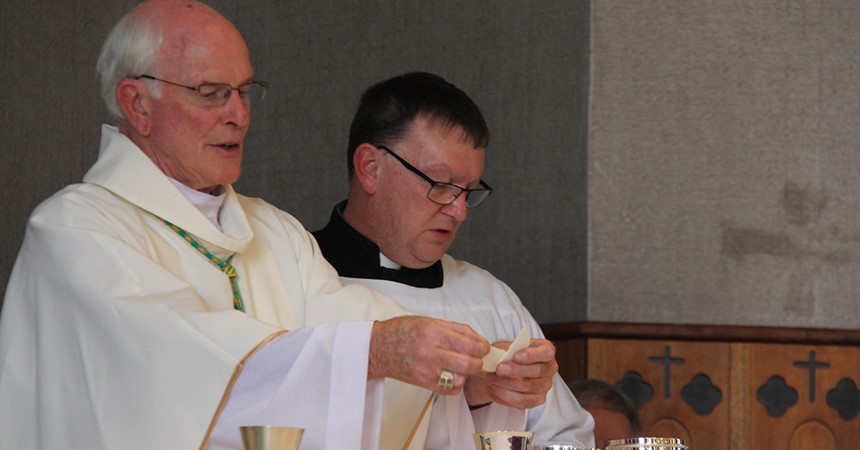Once again you might like to take a moment to gather your reflections from the first, second, third and fourth articles in this series. It is important to remember that the Fraction Rite is the third part of the four-part eucharistic action: take – bless – break – give. It is important to remember that this action is a response to the Word of God we have heard, a word inviting us this week to imagine what the kingdom of heaven is like and to ‘listen anyone who has ears’. (Mt 13: 24-43)
So, guided by our three mystagogical questions, let us listen to the scripture and liturgical texts, and to our experience of the Fraction Rite:
- What do you notice?
- What does it reveal to you/us (about God, Christ, the church, the liturgy …)?
- What does it ask of you/us?
The Fraction Rite – or the ‘Fraction of the bread’ as it is referred to in the General Instruction of the Roman Missal (GIRM) – is part of the Communion Rite. The entire Communion Rite is about unity: a unity characterised by forgiveness, freedom, and peace; a unity found in Christ and shared with our brothers and sisters. The Communion Rite flows as follows:
The Lord’s Prayer
The Rite of Peace
The Fraction of the Bread
Communion
Prayer After Communion
In explaining the meaning of the Fraction Rite, the GIRM (a. 83) references the following scripture reading which is proclaimed on the Feast of the Body and Blood of Christ (A).
The blessing-cup that we bless is a communion with the blood of Christ, and the bread that we break is a communion with the body of Christ. The fact that there is only one loaf means that, though there are many of us, we form a single body because we all have a share in this one loaf.
(1 Cor 10:16-17)
The difficulty we face in appreciating the profound meaning of this simple and pithy rite is the poverty of the symbols and our ritual enactment of the rite. The signs are barely perceptible to the senses. To a large degree they have been compromised by the Church itself. A seeming fear about ensuring respect for the body and blood of Christ on the altar has resulted in a lack of concern and respect for the body of Christ gathered around the altar.
As the scripture indicates, the meaning of the rite is to be found in ONE loaf broken and ONE cup poured out and shared. Interestingly, the GIRM (a. 321) also says that the bread is to have the appearance of food – a sign perceptible to our senses. Yet our common practice is to use multiple single hosts that lack any resemblance to food, and multiple chalices which are on the altar from the preparation of the gifts. In the previous rendition of the Missal the multiple chalices were brought to the altar during the Fraction Rite.
What can we do to strengthen our symbols and rituals so they can carry the great mystery of unity and love they are meant to reveal, and facilitate our participation as celebrants not consumers?
At the very least we could use large scored hosts that not only need to be broken into many pieces, but also have the appearance of being broken off something larger. We would eliminate the less common practice of some presiders using a ‘presider’s host’ that is not shared with any of the Assembly. Such a practice suggests the presider is separate to the Assembly, apart from the one body of Christ. In the absence of one loaf it would be helpful to use only one paten, big enough to hold many larger hosts that need to be broken. Any of these actions would go some way to helping the Fraction Rite become a sign perceptible to our senses and so enable us to become celebrants rather than consumers.
Essentially the Fraction Rite is a visual rite. The meaning is to be perceived in what we see. The action of the breaking is what drives the rite. Yes, it is accompanied by the ‘Lamb of God’ but the ‘Lamb of God’ is not the driver. It only begins when the presider is ready to begin the fraction of the bread. This ordering of the Fraction Rite is indicated by a simple word in the rubrics, ‘meanwhile’. ‘Meanwhile the following is sung or said’ (Missal a. 130)
Lamb of God, you take away the sins of the world,
have mercy on us.
Lamb of God, you take away the sins of the world,
have mercy on us.
Lamb of God, you take away the sins of the world,
grant us peace.
One final comment on the ritual action: there is no reference to the tabernacle in the Fraction Rite, neither in the rite as it is outlined in the Missal, nor in its GIRM. The tabernacle has no place in the celebration of Mass and so it has no place in the Fraction Rite. The altar is the focus. The people are fed from the altar with the bread and wine they have presented – the fruit of the earth and the work of their human hands. (GIRM a. 85)
How do we participate in the Fraction Rite as celebrants rather than consumers? To a significant degree this is dependent on how the presider celebrates this rite. It would help if:
- large easily broken hosts were used
- as far as possible, there are enough ‘hosts’ to feed everyone present
- the tabernacle was only used in an emergency
- the rite began only after the Sign of Peace is complete, silence has fallen, and the attention of the assembly is focused on the action at the altar.
It would also help if music ministers appreciated that the ‘Lamb of God’ accompanies the action of breaking the bread and they take their cue to begin from the presider.
It is up to us as members of the Assembly to be fully attentive to this action as we join our voices to the ‘Lamb of God’. We bring our awareness that this rite expresses our deep unity with Christ and each other. This is a unity so profound that, with Christ, we are broken open and poured out in love for the life of the world. New life comes from death. This is what the symbols are meant to reveal so that we are well disposed to give our AMEN as we receive communion.
The breaking of the bread is a critical and essential part of the eucharistic action. Indeed, as the GIRM (a. 83) reminds us, in the early Church it was the name used for the celebration of eucharist. The disciples on the road to Emmaus recognised Jesus in the breaking of the bread. It was and remains THE sign. Because of that sign they turned around.
What are you pondering? What do you think we are doing when we celebrate the Fraction Rite? What would help you engage with this rite more meaningfully? To what change is God calling you, both in the way you participate in the celebration of The Fraction Rite at Mass and live the mystery it reveals every day? Where and how are you being broken open and poured out in love? The Fraction Rite is rehearsing us for these ‘broken open’ and ‘poured out’ experiences in life.
The world needs us to be celebrants of the liturgy because society needs people who know deep within that fullness of life in not to be found in being a consumer.
You might like to:
- watch a short video on the Fraction Rite featuring Archbishop Mark Coleridge.
- watch a video demonstrating the use of large scored hosts.
- read the ‘Diocesan Guidance on the Communion Rite at Mass’. This document is being revised in light of conversations across the diocesan community last year. The updated version will be available soon.
- Reflect on St Augustine’s famous homily ‘Your own mystery’.
- Listen to the hymn, ‘In the breaking of the bread’ by Chris Ward or ‘Behold the Lamb of God’ by the St Louise Jesuits.
In the next Liturgy Matters we will focus on the fourth of the four-part action – Communion.
Acknowledgements
Prayers and references to the General Instruction of the Roman Missal ¬are from the English Translation of the Roman Missal © 2010 International Committee on English in the Liturgy Inc. (ICEL). All rights reserved.
Photo: © Diocese of Maitland-Newcastle. All rights reserved.

